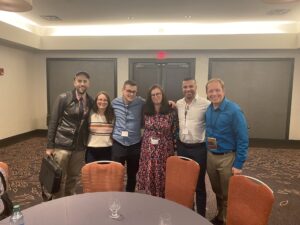
The Corpus and Repository of Writing was initiated by Dr. Shelley Staples and Dr. Bradley Dilger in Fall 2015 and brought together 11 graduate and 2 undergraduate students from two programs, Second Language Studies and Rhetoric & Composition. The Crow team is building a web-based archive which combines a corpus of student writing from first-year composition courses with a repository of pedagogical artifacts such as syllabi and assignments. This unique combination allows us to support research and professional development for the vibrant writing studies communities at Purdue, Arizona, and other partner universities.
Project director Dr. Bradley Dilger started Crow in 2015 with Dr. Shelley Staples, when they realized their interests in building repositories and corpora had much in common. They established a team of students from across Purdue’s graduate programs and explored research questions relevant to student interests and generative for useful skills and knowledge — not to mention academic or professional positions. Indeed, Crow’s leadership team includes three former graduate students (Dr. Michelle McMullin, Dr. Aleksandra Swatek, and Dr. Hadi Banat) now bringing their own students into the project, in addition to Dr. Randi Reppen, a pioneer in using corpus linguistics for teaching.
From its inception, Crow has prioritized user experience, from developing a continually updated “UX Primer” that helps students learn UX methods (Dilger et al., 2024) to using a persona-based model for assessing and shaping student professional development (McMullin et al., 2021). Crow researchers have worked directly with audiences relevant to our corpus and repository platform, including students and instructors at multiple levels. Faculty researchers affiliated with Crow have facilitated a hands-on approach across all work, encouraging students to become involved with corpus building and other Crow research through data processing, programming, writing grants, and developing internal documentation.
Crow researchers have also dedicated extensive effort to exploring the research team model popular in the natural sciences, but in the context of humanities research. Our “Constructive Distributed Work” project, led by Dr. McMullin, is developing a data-driven framework for helping Crow researchers mentor each other and avoiding the negative valences of distributed work — deskilling, overwork, and a loss of professional identity (writecrow.org/cdw). As a result, our team is highly diverse, highly engaged, and highly agile, with student and faculty researchers working together to identify goals representative of the needs of our diverse audiences. Our highly collaborative culture means we can engage new audiences quickly and meaningfully, with mutual benefit.
Key events
- 2024: Crow lab at Purdue moves to Stanley Coulter Hall
- 2024: CCCC Research Initiative grant funded
- 2022: Banat & Swatek added to leadership team
- 2021: First Crow Fellows are selected
- 2021: CIABATTA launched
- 2019: ACLS grant funded
- 2017: Humanities Without Walls grant funded
- 2016: Shelley Staples moves to U of Arizona
- 2015: Crow is founded at Purdue as “Understanding University Writing”